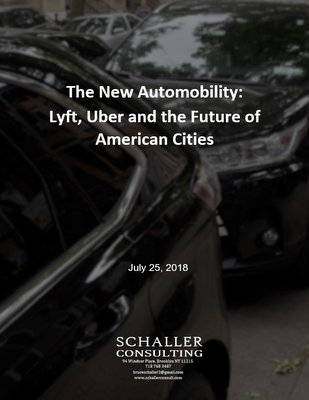| |
THE NEW AUTOMOBILITY:
Lyft, Uber and the Future of American Cities
 Full report: The New Automobility: Lyft, Uber and the Future of American Cities (pdf file)
Full report: The New Automobility: Lyft, Uber and the Future of American Cities (pdf file)
Municipal and civic officials in cities across the country are grappling with how to respond to the unexpected arrival and rapid growth of new mobility services, most notably, ride services such as Uber and Lyft (also called Transportation Network Companies, or TNCs) and “microtransit” companies such as Via and Chariot.
Are these new mobility options friendly to city goals for mobility, safety, equity and environmental sustainability? What risks do they pose for clogging traffic or poaching riders from transit? What will happen when self-driving vehicles are added to ride-hail fleets?
This report combines recently published research and newly available data from a national travel survey and other sources to create the first detailed profile of TNC ridership, users and usage.
The report then discusses how TNC and microtransit services can benefit urban transportation, how policy makers can respond to traffic and transit impacts, and the implications of current experience for planning and implementation of shared autonomous vehicles in major American cities.
Key findings:
TRIPS, USERS AND USAGE
- TNCs transported 2.61 billion passengers in 2017, a 37 percent increase from 1.90 billion in 2016.
- Combined TNC and taxi ridership is likely to surpass local bus ridership in the U.S. by the end of this year, making them among the largest urban transportation providers.
- 70 percent of Uber and Lyft trips are in nine large, densely-populated metropolitan areas (Boston, Chicago, Los Angeles, Miami, New York, Philadelphia, San Francisco, Seattle and Washington DC.)
- TNCs account for 90 percent of TNC/taxi trips in eight of these nine large metro areas (New York is the exception), but taxis serve slightly more passengers than TNCs in suburban and rural areas.
- TNC customers are predominantly affluent, well-educated and skew younger.
ROLE IN URBAN MOBILITY
- TNCs added 5.7 billion miles of driving in the nation’s nine largest metro areas at the same time that car ownership grew more rapidly than the population.
- About 60 percent of TNC users in large, dense cities would have taken public transportation, walked, biked or not made the trip if TNCs had not been available for the trip, while 40 percent would have used their own car or a taxi.
- TNCs are not generally competitive with personal autos on the core mode-choice drivers of speed, convenience or comfort. TNCs are used instead of personal autos mainly when parking is expensive or difficult to find and to avoid drinking and driving
SHARED RIDES AND TRAFFIC
- Shared ride services such as UberPOOL, Uber Express POOL and Lyft Shared Rides, while touted as reducing traffic, in fact add mileage to city streets. Even with these shared services, TNCs put 2.6 new TNC vehicle miles on the road for each mile of personal driving removed, for an overall 160 percent increase in driving on city streets.
- Shared rides add to traffic because most users switch from non-auto modes. In addition, there is added mileage between trips as drivers wait for the next dispatch and then drive to a pick-up location. Finally, in even a shared ride, some of the trip involves just one passenger (e.g., between the first and second pick-up).
- TNCs and microtransit can be valuable extensions of – but not replacements for – fixed route public transit
PUBLIC POLICY
- Trip fees, congestion pricing, bus lanes and traffic signal timing can help cities manage current congestion generated by increasing TNC trip volumes combined with other demands on limited street space.
- If additional steps are needed to reduce traffic congestion, policy makers should look toward a more far-reaching goal: less traffic. Key steps involve limiting low-occupancy vehicles, increasing passenger occupancy of TNCs and taxis, changing commercial vehicle operations, and ensuring frequent and reliable bus and rail service.
AUTONOMOUS VEHICLES
- Without public policy intervention, the likelihood is that the autonomous future mirrors today’s reality: more automobility, more traffic, less transit, and less equity and environmental sustainability.
- Policy-makers should steer AV development away from this future starting today with steps to manage TNCs and personal autos and emphasize frequent, reliable and comfortable high-capacity transit service.
Press coverage
- Washington Post: A new study says services like UberPool are making traffic worse
- Curbed: Uber and Lyft not helping Boston’s traffic congestion, new report suggests
- Slate: New Report: Uber and Lyft Riders Aren’t Giving Up Their Cars—They’re Giving Up Transit
- New York Post: Carpooling has only made NYC’s traffic suck more: study
- Streetsblog: Uber and Lyft Are Overwhelming Urban Streets, and Cities Need to Act Fast
|

 Full report: The New Automobility: Lyft, Uber and the Future of American Cities (pdf file)
Full report: The New Automobility: Lyft, Uber and the Future of American Cities (pdf file)